Unlock the C-Programming notes from the BCA solved question paper. For future success, master the foundational concepts of the C programming language with in-depth solutions.
Dudes 🤔.. You want more useful details regarding this subject. Please keep in mind this as well. Important Questions For C-Programming: * Important Short Questions * Solved Question Paper * Syllabus
Section A: C-Programming Very Short Question Answers
Q1. Explain the need for array variables.
Ans. As opposed to defining distinct variables for each value, arrays are used to hold numerous values in a single variable. The data type must be specified along with the array name and square brackets [to build an array]. For instance, let’s say we need to create a programme that can handle 50 employees’ salaries. If we utilise variables to solve this issue, we would require 50 variables to hold employee salaries. The project will become complicated and lengthy because it will be difficult to remember and manage these 50 factors. Declaring a single array with 50 entries, one for each employee’s wage, will address this issue. Now, all we need to remember is the array’s name.
Q2. Distinguish between automatic and static variables.
Ans.
| S. No. | Automatic variables | Static variables |
| 1. | Automatic variables can be accessed within the same block because their scope is always local to the function in which they are declared. | Static variables can be accessed within the same block because their scope is also restricted to the function in which they are declared. |
| 2. | The lifetime of an automated variable is local (limited), and it lasts just until the function is finished running. At that point, the variables are destroyed. | Static variable’s life time is not limited. Since it’s scope is local but the variable will be live (exist) till the program’s execution. |
| 3. | Automatic variables create a new each time when program’s execution enters in the function and destroys when leaves. | Static variable create once, when programme’s execution enters in the function first time, destroys when programme’s execution finishes, they do not again. |
Q3. What is meant by array of structures?
Ans. An array of structure in C-programming is a collection of different datatype variable, grouped together under a single name.
The structural declaration is as follows:
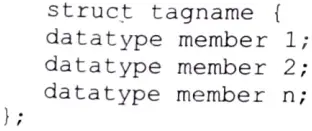


Here, struct is the keyword
tagname specifies name of structure
member 1, member 2 specifies the data items that make up structure.
Q4. What is a pointer ? How is a pointer initialised?
Ans. Pointers : The address of other variables is stored in pointers, which are variables. Our entire data set is kept in the computer’s memory, which is broken up into tiny bytes. Every time we use a variable, it is stored at any memory location because each of these bytes has a unique address.
Initialisation of Pointer Variables
The initialisation of the pointer variable is simple like other variable but in the pointer variable, we assign the address instead of value.
Its system is:
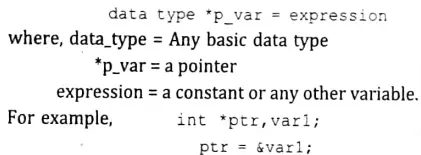


Here in the above example, we have a pointer variable and another is a simple integer variable and we have assigned the pointer variable with the address of the ‘var1’. That means the pointer variable ‘ptr’ now has the address of the variable ‘var1′.
If we want to access the pointer variable, then we have to understand the most important thing that if the ‘*’ asterisk sign is before the pointer variable, this means the pointer variable is now pointing to the value at the location instead of the pointing to location.
Q5. Describe the use and limitations of the function getc.
Ans. The Use of the Function Getc: Both the input-output operations getc and putc use characters. These functions are used for a variety of stream-based input-output operations. To read a character from a stream and move the stream file pointer to the following character in the input stream, use the getc function. To output a character to the output stream, use the putc function.
Limitation of the Function Get: The main drawback getc (), putc () functions are file handling function in C-programming language which is used to read a character from a file (getc) and display on standard output or write into a file (putc).



getc functions is used to read a character from a file. In a C-programme, we read a character as below.



putc function is used to display a character on standard output or is used to write into a file. In a C-programme, we can use putc as below.



Section B: C-Programming Short Question Answer
Q6. What is a data structure? Why is an array called a data structure? Write a program to read a matrix of size mxn and print its transpose.
Ans. An array is a data structure that is designed to store a group of objects of the same or different types. So, they are needed in C programming to store multiple values of same data type. Through arrays, we can represent many instances in one variable.
Array in Data Structure: An array is a linear data structure that collects elements of the same data type and stores them in contiguous and adjacent memory locations. Array work on an index system starting from O to (n – 1), where n is the size of the array.
Program to read a matrix of size m*n and print its transpose
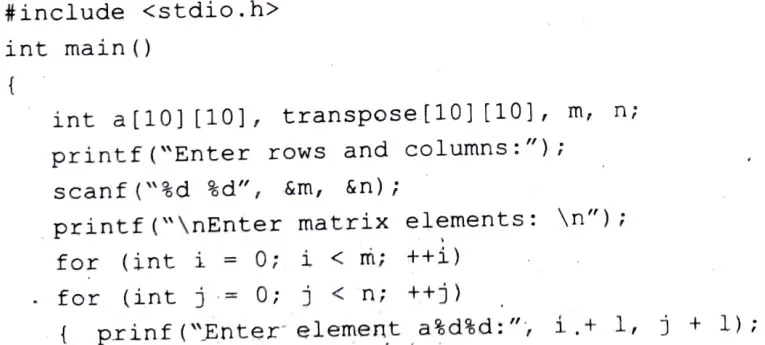


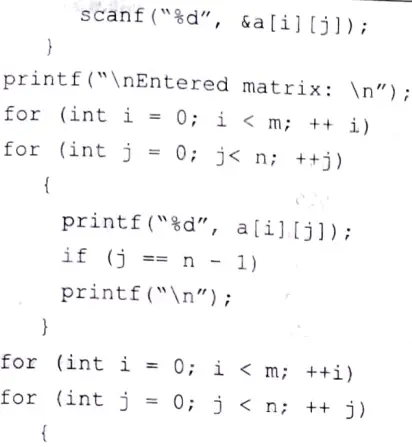


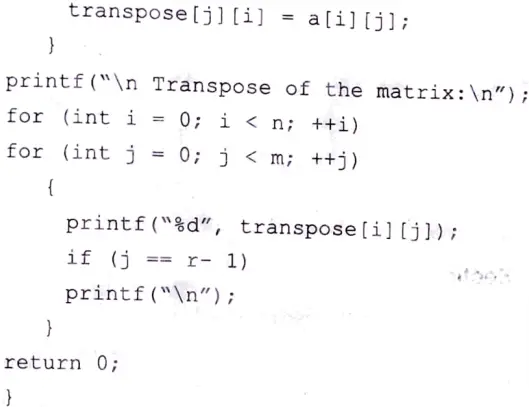


Output:



Q7. Describe the three logical bitwise operators what is the purpose of each what types of operands are required by each of the logical bitwise operators?
Ans. Bitwise AND Operator : This operator is represented as ‘& and is different than &&, the logical AND operator. The & operator operates on two operands. While operating upon these two operands, they are compared on a bit-by-bit basis. Hence, both the operands must be of the same type (either char or int). The second operand is often called an AND Mask. The & operator operates on a pair of bits to yield a resultant bit. The rules that decide the value of the resultant bit are shown below:



This can be represented in a more understandable form as a ‘Truth Table’ shown below:



The example given below shows more clearly what happens while ANDing one operand with another. The rules given in the figure are applied to each pair of bits one by one.
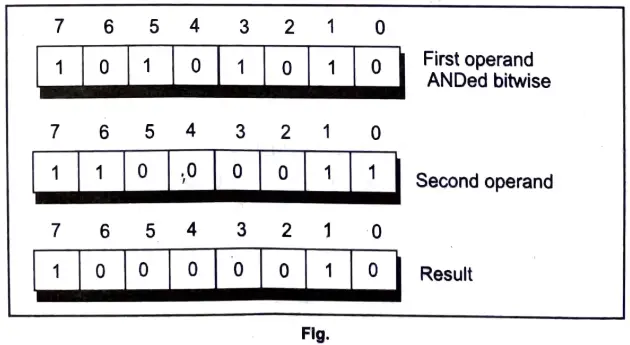


Thus, it must be clear that the operation is being performed on individual bits and the operation performed on one pair of bits is completely independent of the operation performed on the other pairs.
Bitwise XOR Operator : The XOR operator is represented as ’^’ and is also called an exclusive OR operator. The OR operator returns 1, when any one of the two bits or both the bits are 1, whereas XOR returns 1 only if one of the two bits is 1. The truth table for the XOR operator is given below :



XOR operator is used to toggle a bit ON or OFF. A number XORed with another number twice gives the original number. This is shown in the following program :



We can use XOR operator to check whether a given year is leap or not. The following program shows how this can be done :
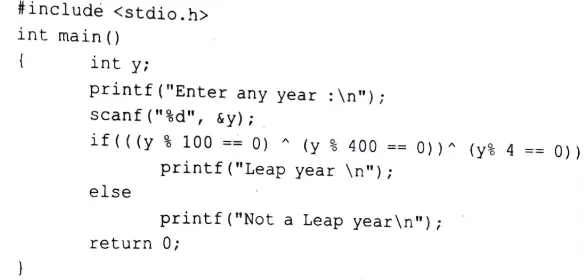


Bitwise OR Operator : Operator is represented as ‘|’. The rules that give the value of the resulting bit obtained after ORing of two bits is shown in the truth table below :
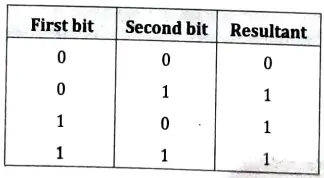


Bitwise OR operator is usually used to put ON a particular bit in a number,
Let us would consider be the bit pattern 11000011.If we want to put ON bit number 3, then the OR mask to be used would be 00001000. Note that all the other bits in the mask are set 0 and only the bit, which we want to set ON in the resulting value is set to 1.
There are three basic operands i.e. AND, OR and NOT. Every complex logical expression can be built using a combination of these operands.
Q8. What is the relationship between an array name and a pointer? How is an array name interpreted when it appears as an argument to a function? How can a function return a pointer to its calling routine?
Ans. Interpretation of Array Name: When an array name appears as an argument to a function, it in fact, passes the base address of the array which is the location of the first element of the array in the memory. That means, the array is passed by address which means that the function it is passed to, can change the values stored in the original array.
For example:



Here, the array name ‘c’ is passed as an argument to function display’ as – display (c [2]);A Function Returning a Pointer: In order for a function to return a pointer to its calling routine, the return type of function should be a pointer to another function. For this, we need to define a type which represents that particular function pointer.
Type def return type (* function_pointer_name) (argument type_1, argument_type_2, ……..,argument _type_n):
This creates a type which represents a pointer for a particular function.
For example:
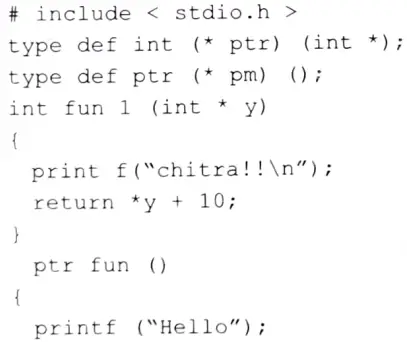


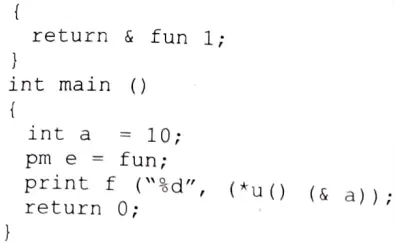


Output: Hello Bachelorexam!!
20
Section C: C-Programming
Q9. (a) Character string in C are automatically terminated by the null character. Explain how this feature helps in string manipulations.
Ans. Strings are usually one-dimensional array of characters terminated by a null character ‘\0’. In fact, we do not place the null character at the end of a string constant. But the c compiler automatically places the ‘\0′ at the end of the string when it initialises the array. In c, strings are just a sequence of characters accessed via a pointer to the first character:. There is no space in a pointer to store the length so we need some indication of where the end of the string is. Hence, it was decided to indicate this by a null character.
This feature widely helps in string manipulations because programs that manipulate string often need to compute a character string’s length. The function ‘strlen’ in the standard library takes a string as its argument and returns the string’s length expressed as an integer. The length computation starts at the beginning of the string and examine each character in order until it reaches the null character. The function is represented as–strlen (S1);
There are some other functions also that manipulate null – terminated strings:
1. strcpy (S1, S2); – It copies string S2 into string S1.
2. strcat (S1, S2); – It concatenates string S2 onto the end of string S1. (15 x 3 = 45)
3. strcmp (S1, S2); – It returns 0 if S1 and S2 are the same; less than 0 if S1 < S2 and greater than 0 if S1 > S2.
4. strchr (S1, ch); – It returns a pointer to the first occurrence of character ch in string S1
5. strstr (S1, S2); -It returns a pointer to the first occurrence of string S2 in string S1.
(b). Main is a user defined function. How does is differ from other uses-defined functions?
Ans. The main () function is a user-defined function but it is different from other user-defined functions in the following ways:
- 1. The compilers of most of the programming languages are so designed that the main () function constitutes the entry point of the program execution. It defines the point from which the program has to start executing itself though there are many other sub-routines and other user-defined functions included in the program.
- 2. The main () function is the controlling section of our code because even though the control of the program is shifted to the UDF (User Defined Function) during the program execution after a function call from main (), once it’s execution is completed, the control is transferred back to the main () function with some or no return value (as in the case of a void function).
- 3. The main () function provides a platform for calling the first user-defined function in the program.
- 4. It has got its own functionality and structural features with respect to the usage of syntaxes Which cannot be changed by the end user unless he writes his own compiler. But the UDF’s have functions and structures designed by the user or programmer.
- 5. The main () has function definition (the code of a function() but it doesn’t have any function declaration. Though we often use int main () or void main (), these declarations are not compulsory. But a UDF should have such declarations.
- 6. A main () function is a user-defined function in C that means we can pass parameters to the main () function according to the requirement of a program. This function is used to invoke the programming code at the run time, not at the compile time of a program. It provides a platform for calling the first user defined function in the program.
Q10. (a) Compare the working of the function strcat and strncat. Write a program, which read your name from the keyboard and outputs a list of ASCII codes, which represent your name.
Ans. C-Strcat
This function is a concatenation string function. strcat() function concatenates the destination string at the end of the source string. This means it connects two strings. Destination String is appended at the end of source string.
Here is below example:
Source String is: src
Destination String is: city
Syntax for strcat()-strcat(source, destination);
Example:



Output:
Before concatenation destination string = Bombay
After concatenation destination string = Bombay + Nagpur
C-strncat(): This strncat() function is used when u need to concatenate some portion of one string at the end of another string. Here we can give a number of characters that have to concatenate.
Syntax for strncat(): strncat(source, destination, number_of_character)
Example:
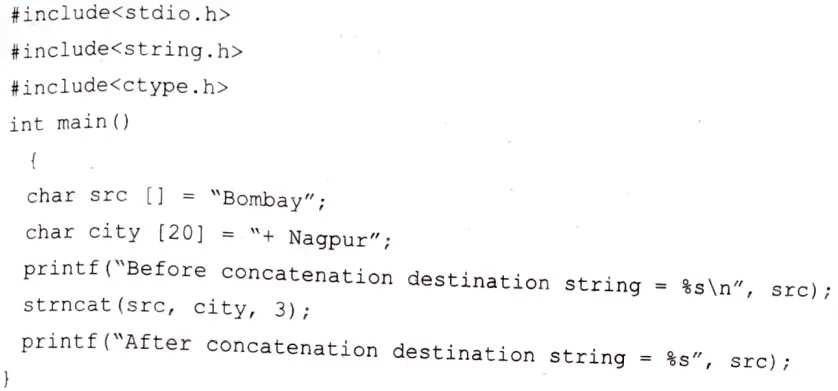


Output:
Before concatenation destination string = Bombay
After concatenation destination string= Bombay + Na
In the example there are 3 characters from destination string is append to source string.
Program that reads the name from the keyboard and outputs a list of ASCII codes which represent the name:
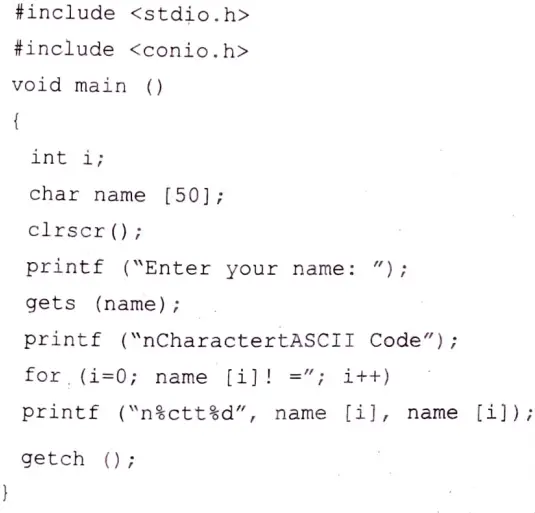


Output
Enter your name: Bachelorexam
| Character | ASCII Code |
| b | 66 |
| a | 97 |
| c | 99 |
| h | 104 |
| e | 101 |
| l | 108 |
| o | 111 |
| r | 114 |
| e | 101 |
| x | 120 |
| a | 97 |
| m | 109 |
(b) What are the rules that govern the passing of arrays to function? Use recursive function calls to evaluate



Ans. Rules Governing the Passing of Arrays to Function
In G, there are several times when we are required to pass an array to a function argument. For example, we have a function to sort a list of numbers: it is more efficient to pass these numbers as an array to function than passing them as variables since the number of elements the user has is not fixed and passing numbers as an array will allow our function to work for any number of values.
The rules that govern the passing of arrays to function are as under:
- 1. In G, an array when passed as a function argument is always treated as a pointer by a function.
- 2. Ways to pass an array to a function in Care Formal parameters as pointer, Formal parameters as sized arrays and formal parameters as unsized arrays.
- 3. It is possible to return an array from a function by changing return type of function to pointer of data type of the array.
- 4. To pass an entire array to a function, only the name of the array is passed as an argument such as result=calculateSum(num);
C-Program to use recursive calls to evaluate



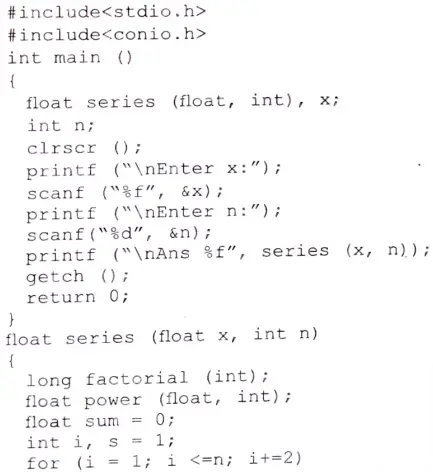


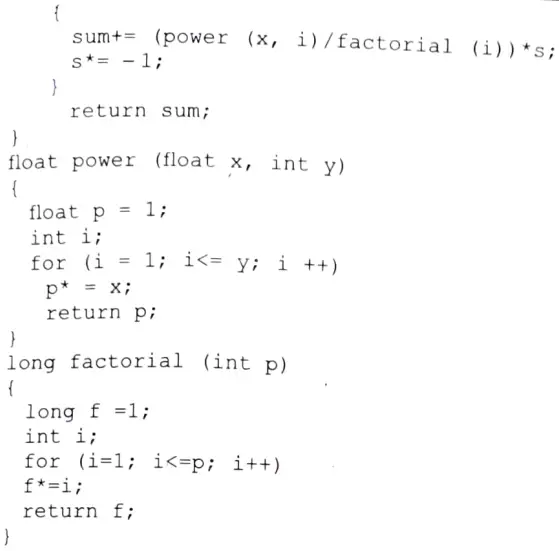


Q11. (a) Explain the meaning and purpose of the following:
(i) Struct keyword
(ii) Typedef keyword
(iii) Size of operator
Ans. (i) Struct Keyword: A user-defined datatype called a structure is used in C to store variables of various data kinds. In C, the word “struct” is used to define a structure. The user must then type the structure’s name after the struct keyword. The data types and the names of the members are then defined inside curly brackets.
Syntax:
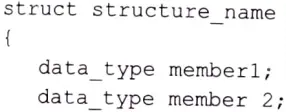


‘struct’ keyword is used to create a structure. We can use this data type to store dates of different attributes of different data types.
(ii) Typedef Keyword: In C programming, the typedef keyword is used to give an existing data type a new name. To redefine a term that already exists, use the typedef keyword. When using datatype names in programmes becomes challenging, typedef is used with user-defined datatypes, which function similarly to creating a command alias.
Syntax:



The typedef keyword gives a meaningful name to the existing data type which helps other users to understand the program more easily. It can be used with structures to increase code readability and we don’t have to type struct again and again. The typedef keyword can also be used with pointers to declare multiple pointers in a single statement. It can be used with arrays to declare any number of variables.
(ii) Size of Operator: Size of is a much-used operator in the C. It is a compile-time unary operator which can be used to compute the size of its operand. The result of size of is of the unsigned integral type which is usually denoted by size_t. Size of can be applied to any data type, including primitive types such as integer and floating-point types, pointer types or compound datatypes such as structure, union, etc.
When size of() is used with the data types, it simply returns the amount of memory allocated to that data type. The output can be different on different machines like a 32-bit system can show different output while a 64-bit system can show different of same data types.
Syntax with Parameters: Size of operator in C has various styles for representation:
- 1. Type: Type is the variable passed in the function to represent the type of data type to be used. size of(type)
- 2. Variable-name: variable-name is the variable passed to the function for determining the bytes occupied by the memory.
- size of(variable-name)
- 3. Expression: It is the parameter that is passed to the functionality for determining the bytes in the memory to compute the values for the expression.
size of (expression)
(b) Write a function that receive a sorted array of integers and an integer value and inserts the value in its correct place.
Ans. Function in C that receive a sorted array of integers and an integer value and inserts the value in its correct place
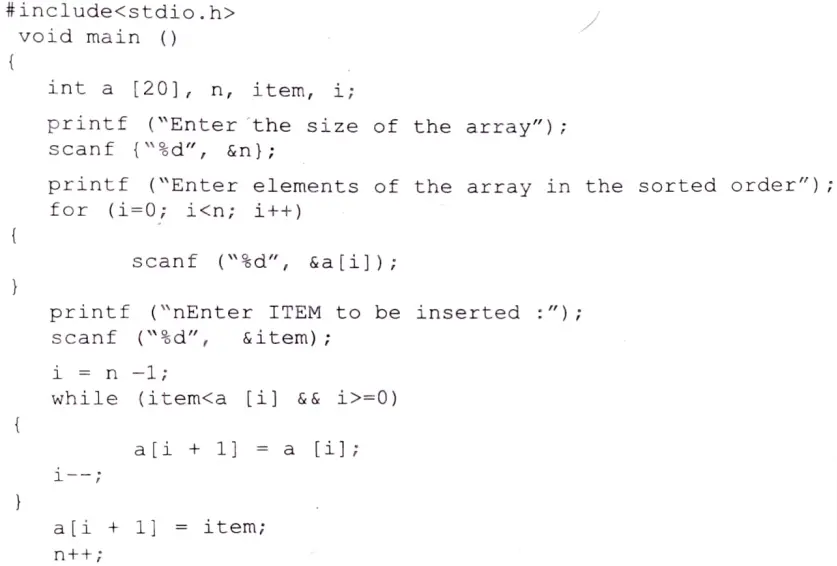





Input:



Output:



Q12. (a) Define auto and register variables in the content of ‘C’: What is the basic difference between these two variables?
Ans. Auto Variable : It is a variable that is defined with the auto specifier within a function or block and is a member of the automatic storage class. If no storage class is specified, all variables defined within a function or block by default belong to automatic storage class. Automatic storage class variables are exclusive to the block in which they are defined and are removed upon block exit.
The following C program demonstrates the visibility level of auto variables :
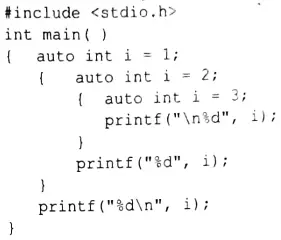


Output :
3 2 1
In the above program we see three definitions for variable i.
So, there could be more than one variable with the same name if these variables are defined in different blocks. Thus, there will be no error here and the program will compile and execute successfully. The printf in the inner most block will print 3 and the variable i defined in the inner most block gets destroyed as soon as control exits from the block. Now control comes to the second outer block and prints 2 then comes to the outer block and prints 1. Here, automatic variable must always be initialised properly, otherwise we are likely to get unexpected results because automatic variables are not given any initial value by the compiler.
Register Variable : The register specifier declares a variable of register storage class called as register variable. Variables belonging to register storage class are local to the block which they are defined in and get destroyed on exit from the block. A register declaration is equivalent to an auto declaration, but hints that the declared variable will be accessed frequently, therefore they are placed in CPU registers, not in memory. Only a few variables are actually placed into registers, and only certain types are eligible; the restrictions are implementation-dependent. However, if a variable is declared as register, the unary & (address of) operator may not be applied to it, explicitly or implicitly. Register variables are also given no initial value by the compiler.
The following piece of code is trying to get the address of variable i into pointer variable P but it won’t succeed because i is declared register, therefore following piece of code won’t compile and exit with error “error : address of register variable requested.”
Program :



Difference between Auto and Register Variables
| S.No. | Basis of difference | Automatic | Register |
| 1. | ldentifier | Auto. | Register. |
| 2. | Access time | Slower than register. | Fastest. |
| 3. | Storage | Memory/Cache. | CPU register. |
| 4. | No. of variables | Large variables can be Created. | Very few variables can be created. |
(b) Give examples of using feof and ferror in a program.
Ans. feof() function in C
In C language, when we are using a stream that links with a file, then we are required to determine that we have come to the end of a file. To solve the problem, we have to compare an integer value to the EOE value. Through the feof() function, we determine whether EOF of a file has occurred or not. The prototype of this function is:
int feof(FlLE* filename);
It returns the value zero when end of the file has not occurred, otherwise it returns 1.
Parameters: FILE* filename
Return type: int(0 or 1)
Example:
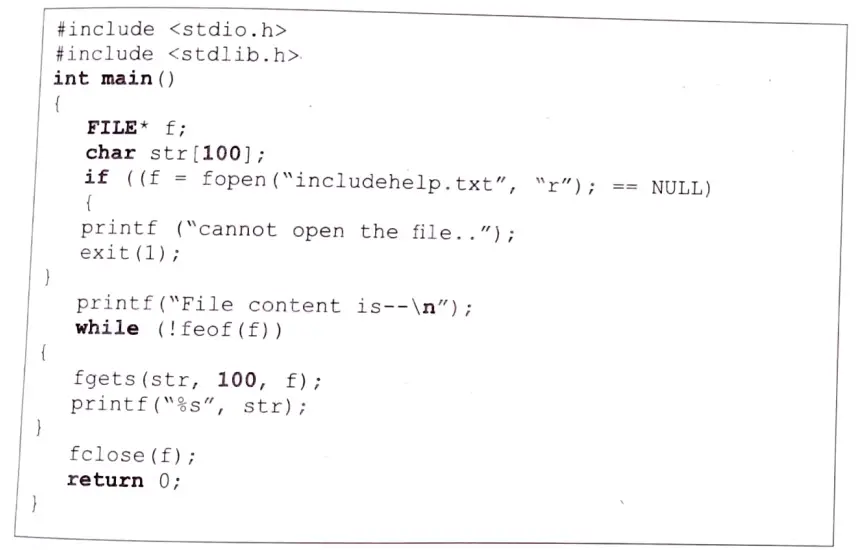


Ferror() function in C
The C library function int ferror(FILE *stream) tests the error indicator for the given stream. Following is the declaration for ferror() function.



Parameters:
Stream: This is the pointer to a FILE object that identifies the stream.
Return Value: If the error indicator associated with the stream was set, the function returns a non zero value else, it returns a zero value.
Example: The following example shows the usage of ferror() function.



Q13. (a) What do you know about bitwise operator? Explain about some bit wise operators by providing the examples for each?
Ans. Bitwise Operations : Using bitwise operators, operations can be carried out at the bit level in the C programming language. Byte-level operations, which define the bitwise operators’ logical equivalents, the AND, OR, and NOT operators, stand in contrast to bitwise operations. These operators operate on groups of eight bits (referred to as bytes) rather than single bits. This is because a byte is often the smallest addressable memory (i.e., data having a specific memory address) unit. This is true for bitwise operators as well, thus even though they only work with one bit at a time, they are unable to handle inputs smaller than bytes.
Bitwise Operators
C provides six operators for bit manipulation.
1. Bitwise AND “&” : The bitwise AND operator is a single ampersand: &. It is just a representation of AND which does its work on the bits of the operands rather than the truth value of the operands. Bitwise binary AND does the logical AND (as shown in the table below) of the bits in each position of a number in its binary form.
For instance, working with a byte (the char type): 0
The most significant bit of the first number is 1 and that of the second number is also 1 so the most significant bit of the result is 1; in the second most significant bit, the bit of second number is zero, so we have the result as 0.



2. Bitwise OR “|” : Similar to bitwise AND, bitwise OR (inclusive or) is applied to only operators at the bit level. Its result is a 1 if one of the either bits is 1 and zero only when both bits are 0. It symbol is “|” which can be called a pipe.



3. Bitwise XOR “^” : The Bitwise xOR (exclusive or) performs a logical XOR function, which is equivalent to adding two bits and discarding the carry. The result is zero only when we have two zeroes or two ones. XOR can be used to toggle the bits between 1 and 0. Thus, i = i^1 when used in a loop toggles its values between 1 and 0.



4. Bitwise NOT “~” Jone’s complement (unary) : The one’s complement (~) or the bitwise complement gets us the complement of a given number. Thus we get the bits inverted, for every bit 1, the result is bit 0 and conversely for every bit 0, we have a bit 1. This operation should not be confused with logical negation “!”.



5. Shift Operators : There are two bitwise shift operators. They are :
(a) Right Shift Operator : The symbol of right shift operator is ‘>>’, For its operation, it requires two operands. It shifts each bit in its left operand to the right. The number following the operator decides the number of places the bits are shifted (.e. the right operand). Thus, by doing ch >> 3, all the bits will be shifted to the right by three places and so on.
Example : If the variable ch contains the bit pattern 11100101, then ch >> 1 with produce the result 01110010 and ch >> 2 will produce 00111001.
Here blank spaces are generated simultaneously on the left when the bits are shifted to the right When performed on an unslgped type, the operation performed is a logical shift, causing the blanks to be filled by 0s (zeros). When performed on a signed type, an arithmetic shift is performed, cuSing the blank lo be filled with the sign bit of the left operand, Right shift can be used to divide a bit pattern by 2.
(b) Left Shift Operator : The symbol of left operator is ‘<<‘, It shifts each bit in its left-hand sperand to the lett by the number of positions indicated by the right-hand operand. It works opposite to that of the shit operator, Thus by doing ch << 1 in the above example, we have 11001010. Blank spaces generated are filled up by zeroes as above. Left shift can be used to multiply an integer in multiples of 2.
6. Bitwise Assignment Operators : C provides a compound assignment operator for each binary arithmetic and bitwise operation (i.e. cach operation which accepts two operands). Each of the compound bitwise assignment operators perform the appropriate binary operation and store the result in the left operand.
The bitwise assignment operators are as follows :



(b) Define a macro that receives an array and the number of elements in the array as arguments. Write a program using this macro to print out the elements of an array.
Ans. Macro Defining the Array
A marco is a piece of code in a program that is replaced by the value of the macro. Marco is defined by #define directive. Whenever a macro name is encountered by the compiler, it replaces the name with the definition of the macro. Macro definitions need not be terminated by a semi-colon(;).
A macro that receives an array and the number of elements in the array as arguments is defined as:



Program in C using macro to print out the elements of an array
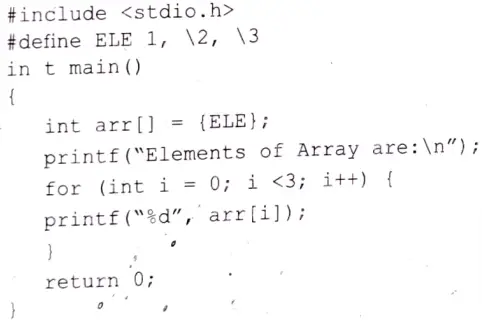


Output



